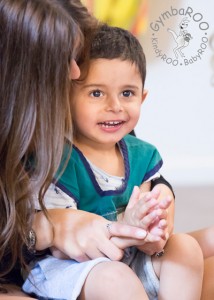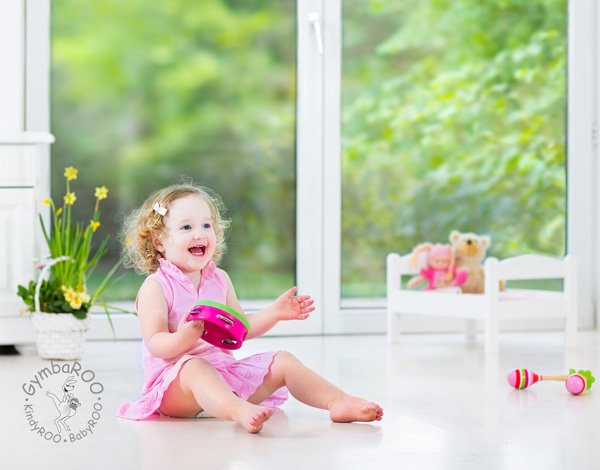Join the thousands of parents already raising smarter, happier babies with our online baby classes: The Active Babies Smart Kids series. Click here.
GymbaROO-KindyROO kids are excelling academically, emotionally, in leadership roles and on the sporting field. Find us at: GymbaROO-KindyROO
At GymbaROO and KindyROO you will have noticed just how many activities we do that involve the use of a regular beat; finger and foot plays, exercises to music, dances, music time on the mat with rhythm sticks, maracas, triangles etc, and even parachute time. Increasingly more neuro-scientific studies are confirming the tremendous benefits of helping our children develop an ability to keep the beat. Enjoy this article written by Dr Anita Collins, regarding the latest research into ‘the beat’ and developing literacy skills.
Just beat it… for literacy
Dr Anita Collins
One of the most common movements young babies work hard to master before they are one, is clapping their hands together. Sometimes this action just completely misses the mark; babies don’t seem to be able to move their two arms in and out at the same time or their hands miss each other entirely. Yet babies love trying to do it and the look of glee, and mild astonishment, on their faces when they do achieve it is wonderful to witness.
 Yet, is it just a fun game for babies to play, just another motor skill they master along their developmental journey, or is it something else, something far more? New research has shown us that when babies master clapping their hands together, a number of neural networks in their brains have made some significant connections. Even more importantly, when babies extend on clapping their hands together and are able to keep a consistent beat, this is an indication that the neural pathways babies need to start learning to read are connected and active.
Yet, is it just a fun game for babies to play, just another motor skill they master along their developmental journey, or is it something else, something far more? New research has shown us that when babies master clapping their hands together, a number of neural networks in their brains have made some significant connections. Even more importantly, when babies extend on clapping their hands together and are able to keep a consistent beat, this is an indication that the neural pathways babies need to start learning to read are connected and active.
What’s in a beat?
 For adults, maintaining a consistent beat is as easy as tapping or clapping along to a piece of music. To adults, this action happens very naturally and without much conscious thought. But let’s think about what keeping a consistent beat really involves.
For adults, maintaining a consistent beat is as easy as tapping or clapping along to a piece of music. To adults, this action happens very naturally and without much conscious thought. But let’s think about what keeping a consistent beat really involves.
To identify a beat in anything, a piece of music, the wheels of a bus or the tick of the traffic light timer, requires us to first separate that sound out from other sounds. Hearing a beat is not as simple as it sounds, we must first filter out all of the other sounds around us in order to identify the beat. For babies this is their first hurdle because they hear sound as one mass, similar to a recording desk in a music studio where all of the dials are turned to full volume. Babies and young children, spend the first seven years of their lives learning how to categorise and filter different sounds out from the mass of sounds they start with. Essentially, there is a record producer inside each baby’s brain, learning how to label and operate the dials to best effect.
The next challenge, after identifying the beat, is telling our limbs to move to the beat. Anyone who has watched a baby ‘bop’ to music, that torso wobble they do when they hear music with a steady beat, will know just how hit and miss these movements can be. However, research has now found that babies are using the beat to teach their limbs how to move in a deliberate way. The distance between each beat helps babies learn how to move their limbs and bodies at a faster or slower speed. These are important steps in learning how to control our movements, and therefore important steps to moving our bodies intentionally.
 The final challenge is maintaining a beat. For babies, this requires developing the ability to gradually increase their attention span from one or two seconds, to ten seconds and beyond. Again this doesn’t sound like a huge ask as an adult, but for a baby this ability leads to being able to move beyond the early steps in learning. Attention, and the ability to focus on anything for longer and longer periods of time, is foundational for all learning tasks.
The final challenge is maintaining a beat. For babies, this requires developing the ability to gradually increase their attention span from one or two seconds, to ten seconds and beyond. Again this doesn’t sound like a huge ask as an adult, but for a baby this ability leads to being able to move beyond the early steps in learning. Attention, and the ability to focus on anything for longer and longer periods of time, is foundational for all learning tasks.
You may well ask what maintaining a consistent beat has to do with reading ability. The research is fairly new in this field, however initial findings challenge many of our understandings about the development of speech and language skills. This research has found that one of the significant mechanisms for speech development comes even before babies begin to speak. It has to do with that mass of sound, that recording desk with all the dials turned up full. The sooner and more effectively our babies brains can separate out speech from all of the other sounds, the sooner they can begin to acquire language. The sooner they begin to acquire language, the more time they have before they start reading to play with language, learn its rules, hear its rhythm, understand how different pitches change the meaning of words. This leads to the ability to identify the difference between a question and a statement for example. The greater mastery of spoken language a baby can acquire before engaging with written language, the easier they will find this next stage of communication and learning. Access GymbaROO’s video on helping to develop your baby’s speech and hearing here.
Beat, therefore, has a lot more to do with learning than we could ever have imagined. The physical embodiment of a beat and the ability to clap a beat consistently is actually the final stage of a large number of neural processes. It is the culmination of far more learning than we ever knew was occurring inside any baby’s brain.
So get out those pots and pans and encourage your little one to beat the drum … for literacy.
Dr Anita Collins (PhD) is the assistant Professor of Music and Arts Education: Faculty of Education, Science, Technology and Mathematics University of Canberra. anitacollinsmusic.com
Active Babies Smart Kids – Online Baby Classes
GymbaROO-KindyROO’s online series of baby classes is taking the parenting world by storm! It is highly recommended by doctors, paediatricians, early childhood experts and the Maternal Child and Family Health Nurses Association. This series is being called: “The essential guide for parents”. Join the thousands of parents already playing with their babies from birth, in the best way for brain and body development and laying crucial foundations for future learning. What happens in the first year, not only matters, it matters a lot! See Introductory video below.
Click here: Active Babies Smart Kids online series of baby classes
Try the first episode FREE: Tummy time + baby fun and development class 1
GymbaROO-KindyROO
Thousands of parents, babies and children are presently involved in our programs and creating rising stars. GymbaROO-KindyROO kids are excelling academically, emotionally, in leadership roles and on the sporting field. Come join all the fun and learning! “GymbaROO – The best decision I ever made for my child.” Classes from 6 weeks old – 7 years GymbaROO KindyROO
Enjoy the following GymbaROO-KindyROO articles
GymbaROO-KindyROO: Who, what, where, why and how
All about GymbaROO-KindyROO’s online baby classes for parents and babies: Active Babies Smart Kids
How to raise a smarter, happier baby
Why active babies make smart kids
Become a GymbaROO-KindyROO franchisee
Supercharge your child’s brain development with music. Latest research. Dr A.Collins
My baby’s got rhythm. Musical activities to share with your baby.
Learning to keep the beat helps your child socially.
The benefits of dancing with your baby.
Six benefits of nursery rhymes

